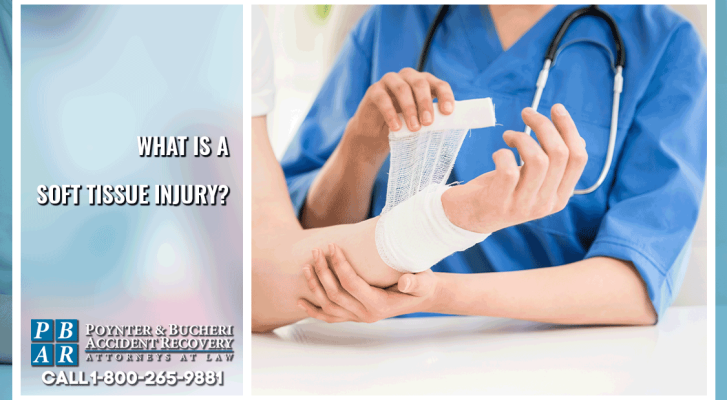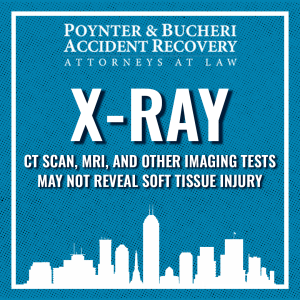
Soft Tissue Injury Settlement After a Slip and Fall Accident

If you’ve suffered a soft tissue injury after a slip and fall accident, you may be entitled to compensation. In this blog, we’ll go into what a soft tissue injury is, how to prove your injury for insurance purposes, and what a soft tissue injury settlement may look like.
What Is a Soft Tissue Injury?
A soft tissue injury can be painful and limiting, affecting your ability to move and function. These injuries involve damage to muscles, ligaments, and tendons, which are the tissues that connect our bones and provide stability to our joints. Soft tissue injuries can result from sudden trauma, such as a fall or collision, or from overuse, such as repetitive strain injuries.
Symptoms of a Soft Tissue Injury
Symptoms can vary depending on the severity and location of the injury but generally include pain, swelling, bruising, and restricted movement. If you have a muscle injury, you may experience stiffness or weakness. And if you have a ligament injury, you may feel instability in the affected joint. Tendon injuries can cause a clicking or snapping sensation and difficulty with movements that require the use of the affected tendon, such as gripping or walking.
Can Soft Tissue Damage Be Permanent?
In some cases, soft tissue damage can be permanent. This is more likely to occur from severe injuries that involve complete tears or ruptures of the tissue. For example, a complete rupture of the Achilles tendon can result in permanent weakness and a decreased ability to walk normally. However, most soft tissue injuries can be successfully treated with conservative measures and do not result in permanent damage.
Types of Soft Tissue Injuries
Soft tissue injuries vary in terms of their severity. Mild injuries, such as sprains or contusions may only involve minor tearing or stretching of the tissue, while more severe injuries can result in complete tears or ruptures. In some cases, a soft tissue injury may also involve damage to surrounding nerves, blood vessels, or other tissues.
While most soft tissue injuries can be treated successfully with conservative measures, such as rest, ice, and physical therapy, some injuries may require more invasive treatment, such as surgery. It is important to follow your healthcare provider’s recommendations for treatment and rehabilitation to promote healing and prevent future injuries.
Proving a Soft Tissue Injury

If you have suffered a soft tissue injury in a slip and fall accident, your first step is filing an insurance claim. Proving a soft tissue injury can be difficult because this type of trauma is not necessarily visible, and it may not even show up on an X-ray, CT scan, MRI, or other imaging test. Victims may experience pain or discomfort a few days or up to a week after the slip and fall accident and so they may not seek treatment right away. An insurer may try to deny your claim, citing that your delay in getting medical care must mean you were not hurt very badly. For this reason, it is always important to seek care right away after a slip and fall injury.
It is very important to document your injuries thoroughly to ensure that you receive a soft tissue injury insurance settlement that is equitable to your pain and suffering. Here are some steps to take:
- Take pictures at the scene of the accident
- Track and save all medical notes and records
- Keep copies of imaging tests and results
- Document any and all work missed due to your injury
- Keep follow-up appointments and treatment with doctors or physical therapists
Soft Tissue Injury Settlements
Going to court for a soft tissue injury settlement can be a complex and stressful process.
The first step in pursuing a settlement is to consult with one of our personal injury lawyers who can advise you on the best course of action and help you navigate the legal process. We will gather evidence to support your case such as medical records, witness statements, and any other relevant documentation.
If the other party is willing to settle out of court, your lawyer will negotiate on your behalf to reach a fair settlement amount. If a settlement cannot be reached, you will face a slip and fall lawsuit to recover your compensation. In court, your lawyer will present evidence and argue your case before a judge or jury.

Going to court for a soft tissue injury settlement can be a lengthy and expensive process. It is important to work closely with your lawyer and be prepared to provide documentation and testimony as needed. The outcome of your case will depend on the strength of the evidence and the judgment of the court.
In some cases, a slip and fall settlement may be awarded as a lump sum payment. In other cases, it may be awarded as ongoing payments over a period of time. Your lawyer can advise you on the best approach for your specific case and help you understand your options. With the help of one of our experienced personal injury lawyers, you can work to obtain the compensation you deserve for your injuries and losses.
Have You Suffered a Soft Tissue Injury in a Slip and Fall?
If you suffered a soft tissue injury after a slip and fall accident, our Indiana personal injury lawyers can help you. Contact Poynter & Bucheri, LLC for your free consultation with one of our attorneys – 1-800-265-9881. You may have the legal right to compensation for your medical bills, lost wages, or pain and suffering.
